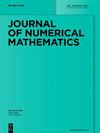球面等方参数化拉伸能量最小化的基本理论及r -线性收敛
IF 4
2区 数学
Q1 MATHEMATICS
引用次数: 0
摘要
本文通过一个立体投影,将有限畸变问题从有界域推广到闭属零曲面。在此基础上,通过最小化单位球面上的总面积畸变能量,给出了单连通封闭曲面M与单位球面𝕊2之间的球面等距参数化的理论基础。在确定了总面积变形能量的最小值后,将其与初始保角映射相结合,确定扩展平面之间的等边映射。从逆立体投影中,我们推导出M和𝕊2之间的等等映射。将总面积畸变能量改写为与南北半球相关的狄利克雷能量之和,并通过交替求解相应的拉普拉斯方程来减小。在此基础上,提出了一种改进的拉伸能量最小化函数,用于计算M和𝕊2之间的球面等参数化。此外,在相对温和的条件下,我们验证了我们提出的算法具有渐近r -线性收敛或形成拟周期解。在各种基准上的数值实验验证了收敛假设的成立,并表明了改进的拉伸能量最小化函数的有效性、可靠性和鲁棒性。本文章由计算机程序翻译,如有差异,请以英文原文为准。
Fundamental Theory and R-linear Convergence of Stretch Energy Minimization for Spherical Equiareal Parameterization
Abstract Here, we extend the finite distortion problem from bounded domains in ℝ2 to closed genus-zero surfaces in ℝ3 by a stereographic projection. Then, we derive a theoretical foundation for spherical equiareal parameterization between a simply connected closed surface M and a unit sphere 𝕊2 by minimizing the total area distortion energy on ̅ℂ. After the minimizer of the total area distortion energy is determined, it is combined with an initial conformal map to determine the equiareal map between the extended planes. From the inverse stereographic projection, we derive the equiareal map between M and 𝕊2. The total area distortion energy is rewritten into the sum of Dirichlet energies associated with the southern and northern hemispheres and is decreased by alternatingly solving the corresponding Laplacian equations. Based on this foundational theory, we develop a modified stretch energy minimization function for the computation of spherical equiareal parameterization between M and 𝕊2. In addition, under relatively mild conditions, we verify that our proposed algorithm has asymptotic R-linear convergence or forms a quasi-periodic solution. Numerical experiments on various benchmarks validate that the assumptions for convergence always hold and indicate the efficiency, reliability, and robustness of the developed modified stretch energy minimization function.
求助全文
通过发布文献求助,成功后即可免费获取论文全文。
去求助
来源期刊
CiteScore
5.90
自引率
3.30%
发文量
17
审稿时长
>12 weeks
期刊介绍:
The Journal of Numerical Mathematics (formerly East-West Journal of Numerical Mathematics) contains high-quality papers featuring contemporary research in all areas of Numerical Mathematics. This includes the development, analysis, and implementation of new and innovative methods in Numerical Linear Algebra, Numerical Analysis, Optimal Control/Optimization, and Scientific Computing. The journal will also publish applications-oriented papers with significant mathematical content in computational fluid dynamics and other areas of computational engineering, finance, and life sciences.

 求助内容:
求助内容: 应助结果提醒方式:
应助结果提醒方式:


